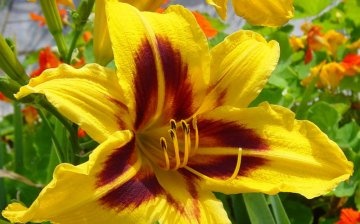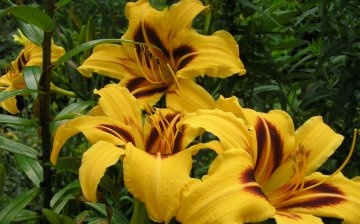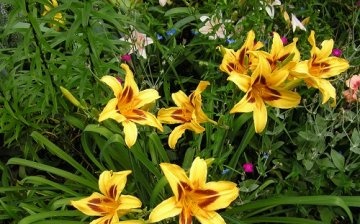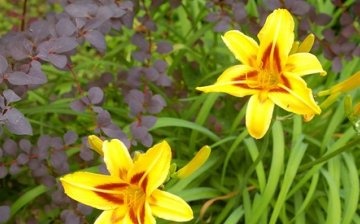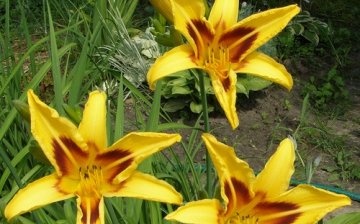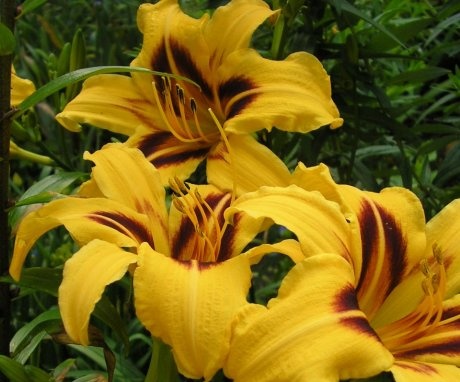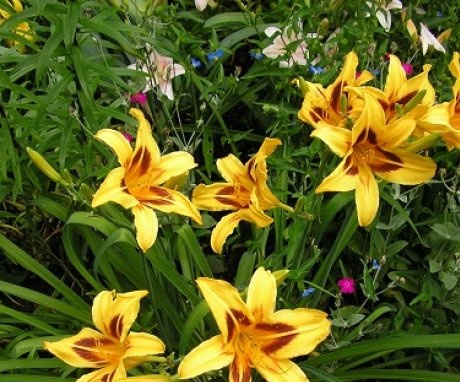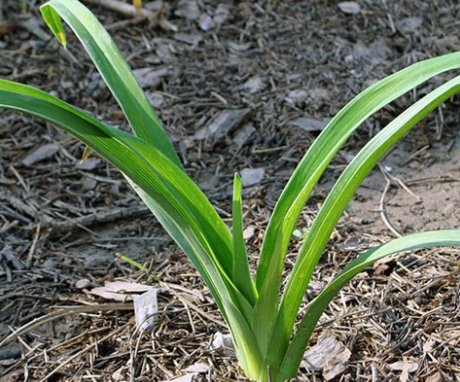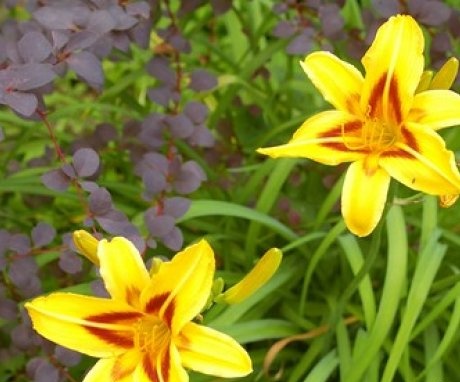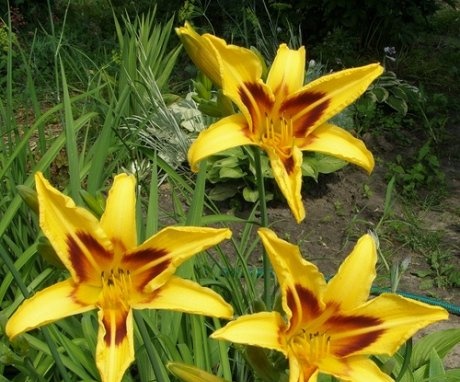Perennial handsome daylily Bonanza
Daylilies recognized as one of the most unpretentious ornamental plants, delighting the grower with lush flowering, a variety of inflorescence shapes and bright colors. Plants are common all over the world, but growers owe a wide range of hybrids and varieties to Australian and American breeders. Thanks to them, today every gardener will be able to grow daylilies of incredible beauty.
Content:
- Description of daylily, hybrids and varieties
- Growing conditions
- Landing: rules and dates
- Bonanza daylily care
- Pests and diseases
Description of daylily, hybrids and varieties
Day-lily is a perennial plant, reaching a height of one or more meters, depending on the species and variety. In horticulture, it is customary to grow low crops - 30-50 cm in height. The daylily has a powerful root system, the branches are thick and fleshy. This allows the plant to survive in hot climates and droughts. Daylily leaves are wide, linear - 2-2.5 cm.
The bush is strongly leafy and represents a densely overgrown hummock, from which stems with inflorescences are thrown. The flowers of the plant in the wild are yellow, orange or red-brown in color. The varieties and hybrids created by breeders have a color of all colors of the rainbow with subtones and shades that smoothly merge into each other. Daylilies grow in one place for up to 15 years.
The plant is propagated vegetatively and using seeds.
The plant can be found in the wild in South Asia, the birthplace of the daylily. Today the culture has spread all over the world. In nature, the daylily prefers to grow in thickets. In this regard, the plant is grown in partial shade in the southern regions and in sunny glades in the northern. The classification of varieties and hybrids of daylily is so extensive that it is rather difficult to understand it. But there are several groups in which the most successful varieties and hybrids are presented:
- Varieties and hybrids in flower shape.
- By the size of the inflorescences.
- By the height of the bush.
- By flowering time.
This classification is considered one of the simplest and most convenient for florists. She is used when choosing the right variety or hybrid. For example, a Bonanza hybrid blooms from June to July for at least three weeks. Suitable for northern regions. If the winters in the region are snowless and cold, it is better to cover plantings with daylilies.
Bonanza hybrid is frost-resistant in winter, drought-tolerant in summer. Undemanding to soil and care. The inflorescence is yellow with red strokes in the core, the flowers are rather large. Despite the unpretentiousness of daylilies, the plant needs to create optimal growing conditions. As a result, the culture will fully unfold and show itself in all its glory.
Growing conditions
If the daylily is planned to be grown in the southern region, it is better to choose a place for the plant in partial shade, next to shrubs or trees. In the northern regions, pick up sunny meadows, plant crops in high flower beds. The best soil option is loam, diluted compost.
If the soil is heavy, clayey, mix it with sand and humus.
It is advisable to add clay and compost to the soil with a predominance of sand. But by and large, the daylily will grow in any garden soil.The main thing is to provide the plant with good drainage in order to avoid root rot.
To avoid the appearance of rust on the daylily in the future, do not plant the plant next to the patinia. Also, you can not plant a culture in places where before that flowers grew that were sick with any fungal diseases, for example, fusarium. The rest of the culture does not require the creation of special conditions.
Landing: rules and dates
Planting dates largely depend on the region - southern or northern. In the latter, it is better to plant the crop in spring, late April or early May. The soil should warm up to 10 °. In the southern regions, planting can be carried out both in spring and in August. If the plant was purchased in the summer, when planting, you need to keep in mind the fact that the plant will take at least a month to adapt and root. Otherwise, the flower freezes out without having time to prepare for winter. It is in this regard that in the northern regions daylilies planted in spring, not August.
If the plant was purchased from a garden center, it must be prepared for planting. To do this, the root system is immersed in a weak root solution or in ordinary water (rainwater). The measure is needed so that the roots are straightened and filled with moisture. This will show which branches need to be cut and which ones should be removed altogether. After that, you can start planting a young plant:
- Prepare the soil - add compost, humus and mix everything thoroughly by digging. If the ground is heavy, be sure to add coarse sand.
- The acidity of the earth should be neutral or slightly acidic.
- For planting, dig a hole approximately 30 cm deep and sprinkle thoroughly with water at room temperature.
- Then gently submerge the root system of the daylily. Begin to gradually fill it up, tamping the earth layer by layer.
- The root collar of the plant should not be deep underground - no deeper than 2 cm.
- Water the plant abundantly after planting.
When choosing a site, keep in mind that the crop will grow rather quickly and will reach about 50-70 cm in width, depending on the variety. Therefore, you should not plant plants close to other flowers or ornamental shrubs.
Approximately a couple of weeks after planting, you can make mineral fertilizers... If the soil has been well fertilized with compost and humus, top dressing can be omitted. The culture is unpretentious, it is better to "underfeed" it than to overdo it with fertilizers.
Bonanza daylily care
The care includes standard procedures:
- Watering is not necessary often, as the soil dries out. Usually, daylilies are watered once every one to two weeks. If it's hot, you can increase the amount of watering up to twice a week. Keep in mind that this plant tolerates drought well and does not like swampy soil.
- To retain moisture, the soil around the bush needs mulch... As a result, the amount of watering and weeding will decrease.
- Plant feeding is carried out twice during the whole season - in spring and in July (after flowering). The second feeding is needed so that the plant gains strength for wintering and forms buds early next year. You can use the well-known fertilizer - Kemira... Frequent fertilization is not recommended, the culture will begin to fatten and will not bloom.
- The care also includes transfer plants. Daylily is best propagated vegetatively - dividing the bush or breeding with the help of daughters. The procedure is carried out when it is time to transplant the culture, it began to bloom poorly - after about 6-10 years. If a variety is grown that forms additional rosettes (daughters), you can separate the mother plant from the rosette and transplant the daughter. If the bush is solid, it is chopped up and seated in different places. This should be done in the spring so that the culture has time to adapt and take root. Otherwise, the daylily may not survive the winter. Many gardeners renew daylilies every five years.As a result, the plant does not have time to grind and pleases the grower with large inflorescences.
Pests and diseases
Daylily is resistant to all sorts of diseases and pests. But this plant also has its enemies - thrips, slugs, as well as rot, rust and fusarium. An insecticide will help get rid of pests. It is more difficult to get rid of diseases. Rot can appear during rainy summers. Rust is only threatened if patrinia grows nearby. Fusarium (fungus) can be brought in with dirty tools or with fertilizer - humus.
To avoid the appearance of fusarium, be sure to treat the soil, for example, Fitosporin.
If the culture is already affected, it is unlikely to be saved. The flower is removed so that the fungus does not spread throughout the site.
Daylily is one of the most unpretentious plants. Growing it does not bring any trouble to the grower. Curbs are decorated with low-growing varieties, planted in the foreground of flower beds. The daylily has become a necessary element of rock gardens and winter gardens. He is planted along the paths, verandas and near the entrance groups. Plants look best in the background hydrangea and other ornamental shrubs. Bright, exquisite flowering and delicate aroma of daylilies delight the grower all summer.
More information can be found in the video:



